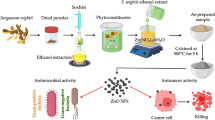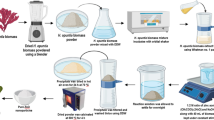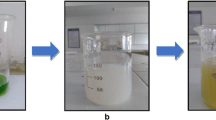Abstract
The present study focused on preparing and characterizing magnetite-polyvinyl alcohol (PVA) hybrid nanoparticles using Acanthophora spicifera marine algae extract as a reducing agent. Various analytical techniques, including UV–Visible spectrometry, Fourier-transform infrared (FTIR) analysis, energy-dispersive X-ray (EDX), scanning electron microscopy (SEM), and X-ray diffraction (XRD) analysis, were used to characterize the nanoparticles. The results showed the successful synthesis of nanoparticles with a characteristic color change and absorption peak at 400 nm in UV–Visible spectrometry. FTIR analysis indicated an interaction between the carboxyl group and magnetite-polyvinyl alcohol hybrid ions. SEM analysis revealed spherical nanoparticles with sizes ranging from 20 to 100 nm. EDX analysis confirmed the presence of strong magnetite peaks in Acanthophora spicifera, validating successful preparation. XRD analysis indicated the crystalline nature of the nanoparticles. Furthermore, the antimicrobial potential of As-PVA-MNPs was evaluated, demonstrating a significant zone of inhibition against tested bacterial and fungal samples at a concentration of 100 µg. These findings suggest the promising antimicrobial activity of the synthesized nanoparticles for potential applications in combating pathogenic microorganisms.






Similar content being viewed by others
Data Availability
The datasets used and analyzed during the current study are available from the corresponding author on reasonable request.
References
Bonnemann, H., & Richards, R. M. (2001). Nanoscopic metal particles—Synthetic methods and potential applications European. Journal of Inorganic Chemistry, 2001, 2455–2480.
Dhand, C., Dwivedi, N., Loh, X. J., Ying, A., Verma, N., Beuerman, R. W., Lakshminarayanan, R., & Ramakrishna, S. (2015). Methods and strategies for the synthesis of diverse nanoparticles and their applications: A comprehensive overview. RSC Advances, 5, 105003–105037.
Cabrera, L., Gutierrez, S., Menendez, N., Morales, M. P., & Herrasti, P. (2008). Magnetite nanoparticles: Electrochemical synthesis and characterization. Electrochimica Acta, 53(8), 3436–3441.
Malik, M. A., Wani, M. Y., & Hashim, M. A. (2012). Microemulsion method: A novel route to synthesize organic and inorganic nanomaterials. Arabian Journal of Chemistry, 5(4), 397–417.
Petcharoen, K., & Sirivat, A. (2012). Synthesis and characterization of magnetite nanoparticles via the chemical co-precipitation method. Material Science and Engineering: B, 177(5), 421–427.
Kumar, D. S. R. S., Senthilkumar, P., Surendran, L., & Sudhagar, B. (2017). Ganoderma lucidum-oriental mushroom mediated synthesis of gold nanoparticles conjugated with doxorubicin and evaluation of its anticancer potential on human breast cancer MCF-7/DOX cells. International Journal of Pharmacy and Pharmaceutical Sciences, 9(9), 267.
Babu, S., Claville, M. O., & Ghebreyessus, K. (2015). Rapid synthesis of highly stable silver nanoparticles and its application for colourimetric sensing of cysteine. Journal of Experimental Nanoscience, 10(16), 1242–1255.
Li, X., Robinson, S. M., Gupta, A., Saha, K., Jiang, Z., Moyano, D. F., & Rotello, V. M. (2014). Functional gold nanoparticles as potent antimicrobial agents against multi-drug-resistant bacteria. ACS Nano, 8(10), 10682–10686.
Bhadury, P., & Wright, P. C. (2004). Exploitation of marine algae: Biogenic compounds for potential antifouling applications. Planta, 219(4), 561–578.
Banas, J. A., Hazlett, K. R., & Mazurkiewicz, J. E. (2001). An in vitro model for studying the contributions of the Streptococcus mutans glucan-binding protein-a to biofilm structure. Methods in Enzymology, 337, 425–433.
Reddy, C. R., Vijeender, K., Bibhuti Bhusan, P., Madhavi, P. P., & Chandrasekhar, S. (2007). Reductive n-alkylation of aromatic amines and nitro compounds with nitriles using polymethylhydrosiloxane. Tetrahedron letters, 48(15), 2765–2768.
Taghizadeh, S. M., Ebrahiminezhad, A., Raee, M. J., Ramezani, H., Berenjian, A., & Ghasemi, Y. (2022). A study of l-lysine-stabilized iron oxide nanoparticles (IONPs) on microalgae biofilm formation of Chlorella vulgaris. Molecular Biotechnology, 64(6), 702–710.
Senthilkumar, P., Surendran, L., Sudhagar, B., Kumar, R. S., & D. S., & Bupesh G. (2019). Hydrothermal assisted Eichhornia crassipes mediated synthesis of magnetite nanoparticles (E-Fe3O4) and its antibiofilm activity. Materials Research Express, 6(9), 095405.
Alfuraydi, R. T., Alminderej, F. M., & Mohamed, N. A. (2022). Evaluation of Antimicrobial and Anti-Biofilm Formation Activities of Novel Poly(vinyl alcohol) Hydrogels Reinforced with Crosslinked Chitosan and Silver Nano-Particles. Polymers, 14, 1619.
Shankhadarwar, S. D. (2015). Phytochemical analysis of red alga Acanthophora spicifera (Vahl) collected from Mumbai, India. Journal of Chemical and Pharmaceutical Research, 7(12), 441–444.
Jamdagni, P., Khatri, P., & Rana, J. S. (2018). Green synthesis of zinc oxide nanoparticles using flower extract of Nyctanthes arbor-tristis and their antifungal activity. Journal of King Saud University-Science, 30(2), 168–175.
Allemailem, K. S., Khadri, H., Azam, M., Khan, M. A., Rahmani, A. H., Alrumaihi, F., & Almatroudi, A. (2022). Ajwa-Dates (Phoenix dactylifera)-Mediated Synthesis of Silver Nanoparticles and Their Anti-Bacterial, Anti-Biofilm, and Cytotoxic Potential. Applied Sciences, 12(9), 4537.
Costerton, J. W., & Stewart, P. S. (2001). Antibiotic resistance of bacteria in biofilms. The Lancet, 358(9276), 135–138.
Costerton, J. W., Stewart, P. S., & Greenberg, E. P. (1999). Bacterial biofilms: A common cause of persistent infections. Science, 284(5418), 1318–1322.
Kouhbanani, M. A., Beheshtkhoo, N., Amani, A. M., Taghizadeh, S., Beigi, V., Bazmandeh, A. Z., & Khalaf, N. (2018). Green synthesis of iron oxide nanoparticles using Artemisia vulgaris leaf extract and their application as a heterogeneous Fenton-like catalyst for the degradation of methyl orange. Material Research Express, 5, 115013.
Yew, Y. P., Shameli, K., Miyake, M., Kuwano, N., Bt Ahmad Khairudin, N. B., Bt Mohamad, S.E., & Lee, K. X. (2016) Green synthesis of magnetite (Fe3O4) nanoparticles using seaweed (Kapp.,aphycus alvarezii) extract. Nanoscale Research Letters, 11276.
Basavegowda, N., Magar, K. B. S., Mishra, K., & Lee, Y. R. (2014). Green fabrication of ferromagnetic Fe3O4 nanoparticles and their novel catalytic applications for the synthesis of biologically interesting benzoxazinone and benzthioxazinone derivatives. New Journal of Chemistry, 38(11), 5415–5420.
Basavegowda, N., Mishra, K., & Lee, Y. R. (2014). Sonochemically synthesized ferromagnetic Fe3O4 nanoparticles as a recyclable catalyst for the preparation of pyrrolo [3, 4-c] quinoline-1,3-dione derivatives. RSC Advances, 4(106), 61660–61666.
Ebrahiminezhad, A., Bagheri, M., Taghizadeh, S. M., Berenjian, A., & Ghasemi, Y. (2016). Biomimetic synthesis of silver nanoparticles using microalgal secretory carbohydrates as a novel anticancer and antimicrobial agent. Advances in Natural Sciences: Nanoscience and Nanotechnology, 7(1), 015018.
Bhuiyan, M. S. H., Miah, M. Y., Paul, S. C., Aka, T. D., Saha, O., Rahaman, M. D., Sharif, M. J. I., Habiba, O., & Ashaduzzaman, M. (2020). Green synthesis of iron oxide nanoparticle using Carica papaya leaf extract: Application for photocatalytic degradation of remazol yellow RR dye and antibacterial activity. Heliyon, 6(8), e04603.
Qasim, S., Zafar, A., Saif, M. S., Ali, Z., Nazar, M., Waqas, M., Haq, A. U., Tariq, T., Hassan, S. G., Iqbal, F., Shu, X. G., & Hasan, M. (2020). Green synthesis of iron oxide nanorods using Withania coagulans extract improved photocatalytic degradation and antimicrobial activity. Journal of Photochemistry and Photobiology B: Biology, 204, 111784.
Ishwarya, R., Vaseeharan, B., Kalyani, S., Banumathi, B., Govindarajan, M., Alharbi, N. S., & Benelli, G. (2018). Facile green synthesis of zinc oxide nanoparticles using Ulva lactuca seaweed extract and evaluation of their photocatalytic, antibiofilm and insecticidal activity. Journal of Photochemistry and Photobiology B: Biology, 178, 249–258.
Kumar, K. M., Mandal, B. K., Kumar, K. S., Reddy, P. S., & Sreedhar, B. (2013). Biobased green method to synthesise palladium and iron nanoparticles using Terminalia chebula aqueous extract. Spectrochimica Acta Part A: Molecular and Biomolecular Spectroscopy, 102, 128–133.
Mukherjee, S., Gole, B., Song, Y., & Mukherjee, P. S. (2011). Synthesis, structures, and magnetic behavior of a series of copper (II) azide polymers of Cu4 building clusters and isolation of a new hemiaminal ether as the metal complex. Inorganic Chemistry, 50(8), 3621–3631.
Yuvakkumar, R., & Hong, S. I. (2014). Green synthesis of spinel magnetite iron oxide nanoparticles. Advanced Materials Research, 1051, 39–42.
Varadavenkatesan, T., Lyubchik, E., Pai, S., Pugazhendhi, A., Vinayagam, R., & Selvaraj, R. (2019). Photocatalytic degradation of Rhodamine B by zinc oxide nanoparticles synthesized using the leaf extract of Cyanometra ramiflora. Journal of Photochemistry and Photobiology B: Biology, 199, 111621.
Jagathesan, G., & Rajiv, P. (2018). Biosynthesis and characterization of iron oxide nanoparticles using Eichhornia crassipes leaf extract and assessing their antibacterial activity. Biocatalysis and Agricultural Biotechnology, 13, 90–94.
Acknowledgements
The authors extend their appreciation to the Researchers supporting project number (RSP2023R316) King Saud University, Riyadh, Saudi Arabia National Center for Inter-University Research Facilities, Seoul National University 2020R1G1A1012069.
Author information
Authors and Affiliations
Contributions
Conceptualization, RSKDS and SP.; methodology and validation, HS; formal analysis, GS; investigation, RKDS; data curation, GD; writing and original draft preparation, PAM; writing, reviewing, and editing of the manuscript, HS, RRM, AAH, MAAD, SWC, and BR; visualization, SP; supervision and project administration, RSDS.
Corresponding authors
Ethics declarations
Conflict of Interest
The authors declare there are no conflicts of interest.
Additional information
Publisher's Note
Springer Nature remains neutral with regard to jurisdictional claims in published maps and institutional affiliations.
Rights and permissions
Springer Nature or its licensor (e.g. a society or other partner) holds exclusive rights to this article under a publishing agreement with the author(s) or other rightsholder(s); author self-archiving of the accepted manuscript version of this article is solely governed by the terms of such publishing agreement and applicable law.
About this article
Cite this article
Kumar, D.S.R.S., Puthiran, S.H., Selvaraju, G.D. et al. Preparation and Characterization of Magnetite-Polyvinyl Alcohol Hybrid Nanoparticles (As-PVA-MNPs) Using Acanthophora spicifera Marine Algae Extract for Enhanced Antimicrobial Activity Against Pathogenic Microorganisms. Mol Biotechnol (2023). https://doi.org/10.1007/s12033-023-00903-y
Received:
Accepted:
Published:
DOI: https://doi.org/10.1007/s12033-023-00903-y




